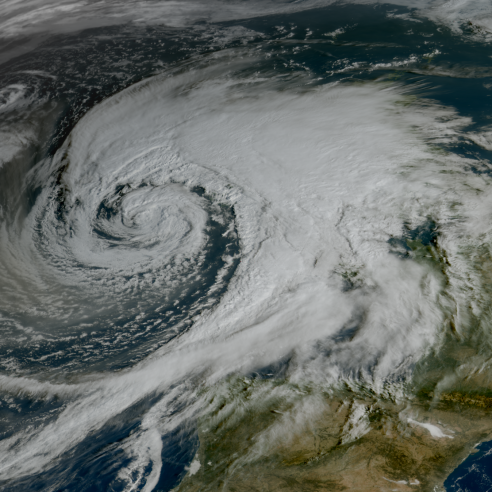
A celestial pas de trois
Repositioning three of Europe’s crucial Meteosat meteorological satellites.


The Flight Operations teams at EUMETSAT’s Darmstadt headquarters are carrying out an intricate, nearly two-month-long process to reposition the satellites.
01 November 2023
01 January 2018
The reason?
To ensure the best possible configuration of more than a billion euros worth of geostationary satellite technology for monitoring severe weather over Europe and Africa, and the climate, from space.
The prelude
On 15 July, 2015, Meteosat-11, the last of EUMETSAT’s Meteosat Second Generation satellites, was successfully launched. After a comprehensive series of manoeuvres, tests and reviews, the satellite was “parked” in the geostationary ring, 36,000km above the equator at 3.4°W, in in-orbit storage.
Storing the satellite in orbit ensured it was immediately ready to replace one of its ageing siblings if necessary and was a cheaper option than storing the spacecraft on the ground. Since early January, Meteosat-11 has been taken out of storage and tested. Now, it’s time to bring the satellite into active service.
This means Meteosat-10 and Meteosat-9 also need to be moved and the missions carried out by the spacecraft changed.
The choreography
From early February to mid-March, the following moves will be made:
- Meteosat-11 will move from 3.4°W to 0° longitude, where it will take over responsibility for the prime “full disc” service currently performed by Meteosat-10. This service provides an image of the whole of Europe and Africa and parts of the Atlantic and Indian oceans every 15 minutes.
- Meteosat-10 will be moved from 0° to 9.5°E, where it will take over the Rapid Scan Service from Meteosat-9. The Rapid Scan Service provides an image of Europe only, every five minutes.
- Meteosat-9 will move from 9.5°E to 3.5°E, where it will act as a back-up to the other two satellites
From early February to mid-March, the following moves will be made:
- Meteosat-11 will move from 3.4°W to 0° longitude, where it will take over responsibility for the prime “full disc” service currently performed by Meteosat-10. This service provides an image of the whole of Europe and Africa and parts of the Atlantic and Indian oceans every 15 minutes.
- Meteosat-10 will be moved from 0° to 9.5°E, where it will take over the Rapid Scan Service from Meteosat-9. The Rapid Scan Service provides an image of Europe only, every five minutes.
- Meteosat-9 will move from 9.5°E to 3.5°E, where it will act as a back-up to the other two satellites
Flight Dynamics Team Leader for the geosynchronous satellites, Stefano Pessina, explains. “During the relocations, Meteosat-11 will be the first to move eastwards, to occupy the slot at 0°,” Stefano said.
“Meteosat-10 will make that slot free and drift eastwards, to occupy the slot where Meteosat-9 currently is.
“Lastly, Meteosat-9 will drift westwards, to reach the currently empty slot at 3.5°E.”
Sound simple?
Flight dynamics engineers at EUMETSAT’s Darmstadt headquarters will need to plan four manoeuvres for each of the satellites.
At the same time, the MSG satellites’ vital service – providing data needed for “nowcasting” severe weather events, in addition to information essential for climate monitoring, must be maintained.
“All of the manoeuvres need to be properly synchronised among the satellites,” Stefano said.
“Two main challenges have to be taken into consideration.
“Firstly, the satellites need to be outside the geosynchronous area populated by other active satellites, to avoid the risk of collision. The further away from the GEO ring, the safer. “Secondly, the use of propellant for the transfer manoeuvres needs to be minimised. The closer to the GEO ring, the cheaper.
“A drift rate of slightly less than 0.5° per day was chosen, with a safety distance of at least 30km from all known synchronous objects on the way.”
A wide range of expertise (and a lot of planning) is required to enable these changes to occur smoothly in addition to that of the flight dynamics engineers - teams responsible for satellite operations, services for the users of our data, image and product specialists, and central facilities and ground station teams, are involved.
The MSG satellites (the troupe)
EUMETSAT exploits four Meteosat Second Generation (MSG) satellites: Meteosat-8, -9, -10 and -11.
Meteosat-8 is positioned at 41.5°E where, along with Indian, Chinese and Russian geostationary satellites, it contributes to monitoring the Indian Ocean region.
From there, it provides observations which bring benefits not only to people living on Indian Ocean islands and in countries on the east coast of Africa that experience tropical cyclones, but also to countries in Central Europe.
As Meteosat-8 took up this position in 2016, after an 80-day voyage from its previous position at 3.5°E, the focus of this post, and the current month-long celestial pas de trois taking place at an altitude of 36,000km, is on Meteosat-9, -10 and -11.
"All of the activities need to be planned in detail,” Spacecraft Operations Team Leader Lee Matheson said.
“Once the satellites are moving, we will face the challenge of having several satellites shifting at the same time, in some cases generating interference with each other. That needs to be taken into consideration.
“The whole manoeuvre is a complex activity, involving simultaneous moves of three satellites all within one month, then assigning them new missions.”
This animation comprises one image per day taken by Meteosat-8 during its 80-day voyage from 3.5°E to 41.5°E in 2016





